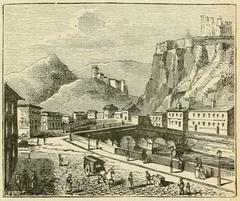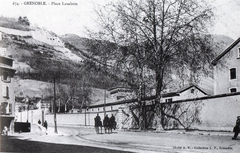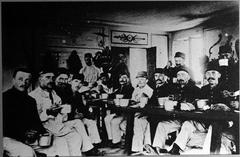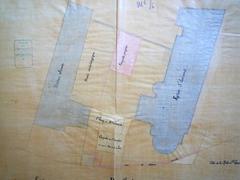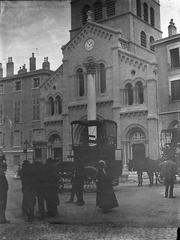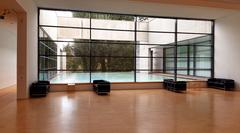Institut de Radioastronomie Millimétrique (IRAM): Visiting Hours, Tickets, and Grenoble Historical Sites Guide
Date: 14/06/2025
Introduction to Institut de Radioastronomie Millimétrique (IRAM) Grenoble
Located in the heart of Grenoble, France, the Institut de Radioastronomie Millimétrique (IRAM) is a premier European center for millimeter-wave radio astronomy. Established in 1979 as a multinational initiative between the French CNRS, German Max-Planck-Gesellschaft, and later the Spanish Instituto Geográfico Nacional, IRAM has become a symbol of international scientific cooperation and technological advancement (IRAM History, IRAM Mission).
IRAM’s headquarters in Grenoble, nested within the city’s vibrant scientific district, manage two state-of-the-art observatories: the NOEMA array in the French Alps and the 30-meter telescope in Spain’s Sierra Nevada. These facilities are pivotal for research into the cold, dense regions of the universe, leading to discoveries such as new interstellar molecules, imaging of distant galaxies, and vital contributions to the Event Horizon Telescope’s first image of a black hole (IRAM Facilities, EHT Black Hole Image).
This comprehensive guide covers IRAM’s heritage, research achievements, and practical visitor information—including visiting hours, guided tours, ticketing, accessibility, and travel tips. You’ll also find recommendations for nearby scientific and historical attractions in Grenoble, ensuring your visit is both educational and culturally enriching (IRAM Visitor Information, OSUG).
Table of Contents
- Introduction
- IRAM’s History and Development
- IRAM’s Observatories
- Scientific Achievements and Innovation
- Visiting IRAM: Practical Guide
- IRAM Grenoble: Facilities & Research
- Discover IRAM: Visitor Experience & Cultural Impact
- Frequently Asked Questions (FAQs)
- Planning Your Visit
- Conclusion
- References
IRAM’s History and Development
Founding and Early Years
IRAM was founded in 1979 as a pioneering joint venture between France’s CNRS and Germany’s Max-Planck-Gesellschaft. The Spanish Instituto Geográfico Nacional (IGN) joined soon after, becoming a full member in 1990. The institute was created to explore the universe at millimeter wavelengths—a spectrum ideal for studying the cold, dense regions where stars and galaxies form (IRAM History, IRAM Mission).
Growth as a Multinational Hub
From its inception, IRAM has embodied international collaboration, employing scientists, engineers, and support staff from over ten countries. By 2025, IRAM employs more than 120 staff across its French and Spanish sites (IRAM About). The institute collaborates with universities and research organizations globally, including the University of Michigan, Nanjing University, and the Purple Mountain Observatory, expanding its influence in the worldwide astrophysics community (IRAM Global Outreach).
IRAM’s Observatories
NOEMA (Northern Extended Millimeter Array)
NOEMA, situated on the Plateau de Bure in the French Alps at 2,550 meters altitude, is the most powerful millimeter-wave observatory in the Northern Hemisphere. Its 12 high-precision parabolic antennas can be configured for high-resolution imaging of cosmic phenomena, offering cutting-edge capabilities for radio astronomy (NOEMA Overview).
IRAM 30-meter Telescope
Located in Spain’s Sierra Nevada mountains, the 30-meter telescope is one of the world’s largest and most sensitive single-dish millimeter telescopes. It enables detailed studies of molecular gas and dust, playing a crucial role in astrochemistry and star formation research (IRAM Observatories).
Both observatories are placed at high altitudes to minimize atmospheric interference, ensuring optimal conditions for observing the universe’s coldest regions (IRAM Facilities).
Scientific Achievements and Innovation
IRAM’s telescopes have been central to many astronomical milestones:
- Interstellar Molecule Discovery: About one-third of all known interstellar molecules have been discovered with IRAM’s instruments (IRAM Discoveries).
- Imaging Galaxies and Star Formation: NOEMA has observed the most distant galaxies, while the 30-meter telescope has mapped molecular gas in nearby galaxies (IRAM Science).
- Planet Formation Insights: Imaging of gas disks and detection of planet-forming regions around double stars (IRAM Wikipedia).
- Event Horizon Telescope (EHT) Collaboration: Both observatories contributed to the first image of a black hole and, later, the Milky Way’s central black hole (EHT Black Hole Image).
IRAM’s laboratories in Grenoble and Granada advance millimeter technology, benefiting not only IRAM but the international astronomy community (IRAM Technology).
Visiting IRAM: Practical Guide
Visiting Hours
- Headquarters in Grenoble: Open Monday–Friday, 9:00 AM–5:00 PM. Access to laboratories and observatories is limited, typically available during special events or by prior arrangement.
Guided Tours & Tickets
- Tours: Offered during science festivals, open days, and by appointment. Book in advance through the IRAM website or local tourism offices.
- Tickets: Most events are free but may require prior registration due to limited space.
Accessibility & Directions
- Accessibility: The Grenoble facilities are wheelchair accessible. Visitors with special needs should contact IRAM ahead of time.
- Directions: Located on the Université Grenoble Alpes campus, reachable by tram, bus, taxi, or on foot from the city center. Parking is available but limited; public transportation is recommended.
Nearby Attractions
- Scientific Sites: European Synchrotron Radiation Facility (ESRF), Institut Laue-Langevin (ILL).
- Historical Sites: Grenoble Bastille fortress, Musée de Grenoble, Old Town.
For more details, refer to IRAM Visitor Information.
IRAM Grenoble: Facilities & Research
Facilities
- Administrative and Scientific Headquarters: Houses administrative offices, scientific departments, technical labs, and data processing centers (Larousse).
- Support Infrastructure: Includes meeting and conference rooms, user support, and a scientific library.
Research Highlights
- Core Areas: Molecular clouds, astrochemistry, and planetary atmospheres.
- Observatory Operations: Supports NOEMA and the 30-meter telescope, develops instrumentation and software (OSUG).
- International Collaborations: Partners with ALMA, CNRS, Max-Planck-Gesellschaft, IGN, and ESO.
- Data Analysis: Processes large datasets for star formation, astrochemical mapping, and solar system studies.
- Training and Outreach: Offers internships, workshops, and public engagement activities.
Discover IRAM: Visitor Experience & Cultural Impact
What to Expect
- Guided Tours: Explore IRAM’s history and technology through expert-led tours.
- Interactive Exhibits: Learn about radio astronomy with hands-on displays.
- Meet the Scientists: Attend Q&A sessions and presentations on recent research.
- Special Events: Participate in open days and science festivals.
Educational and Cultural Impact
IRAM is committed to making complex scientific knowledge accessible through public events, collaborations with schools, and citizen science projects.
Nearby Cultural Attractions
- Grenoble Bastille: Offers panoramic city and mountain views.
- Musée de Grenoble: Home to extensive art collections.
- Old Town: Features historic architecture, shops, and cafes.
Frequently Asked Questions (FAQs)
Q: Can I visit IRAM’s observatories?
A: Public access is generally restricted. Tours may be available during special events.
Q: What are IRAM’s visiting hours in Grenoble?
A: Headquarters are open weekdays, 9:00 AM–5:00 PM. Check the website for event schedules.
Q: Are guided tours available?
A: Yes, during special events and by appointment.
Q: Is IRAM accessible for people with disabilities?
A: Yes, facilities are wheelchair accessible.
Q: What else can I see in Grenoble?
A: ESRF, ILL, Grenoble Bastille, and the Musée de Grenoble are recommended.
Planning Your Visit
- Book in Advance: Register for tours or events ahead of time.
- Combine Visits: Pair your IRAM tour with local historical or scientific attractions.
- Use Public Transit: For convenience and to reduce environmental impact.
- Prepare for Weather: Dress accordingly for possible outdoor segments.
For updates, visit the IRAM official website and follow their social media channels. The Audiala app also provides tour info and event updates.
Conclusion
The Institut de Radioastronomie Millimétrique (IRAM) stands at the crossroads of scientific innovation and public engagement. Visiting IRAM Grenoble offers a unique opportunity to witness the forefront of radio astronomy, interact with leading researchers, and explore a city rich in both scientific and cultural heritage. Whether you’re a seasoned astronomy enthusiast or a curious traveler, IRAM provides an inspiring journey into the mysteries of the cosmos and the vibrant community that seeks to unravel them.
Plan your visit to IRAM today, and experience the intersection of science, technology, and culture in Grenoble.
References and Further Reading
- Institut de Radioastronomie Millimétrique (IRAM) History and Mission
- Institut de Radioastronomie Millimétrique (IRAM) Wikipedia
- IRAM Observatories Overview
- European Southern Observatory User Support Group (OSUG)
- Event Horizon Telescope Collaboration and IRAM Contribution
- Discover IRAM Grenoble Visitor Information
- Visiting IRAM: Tours, Tickets, and Visitor Tips
- Larousse - Institut de Radioastronomie Millimétrique

